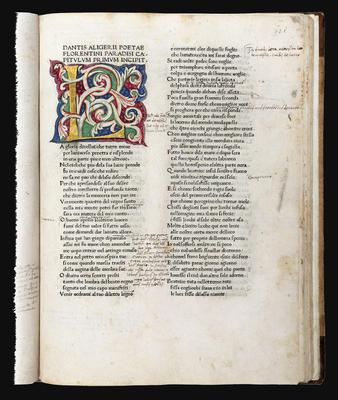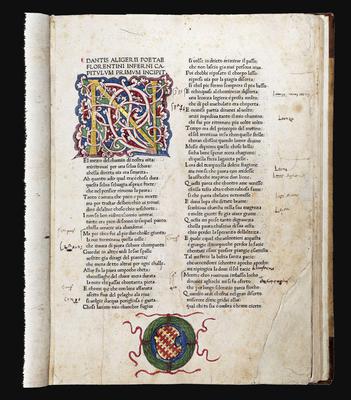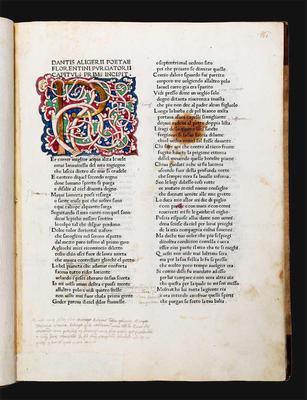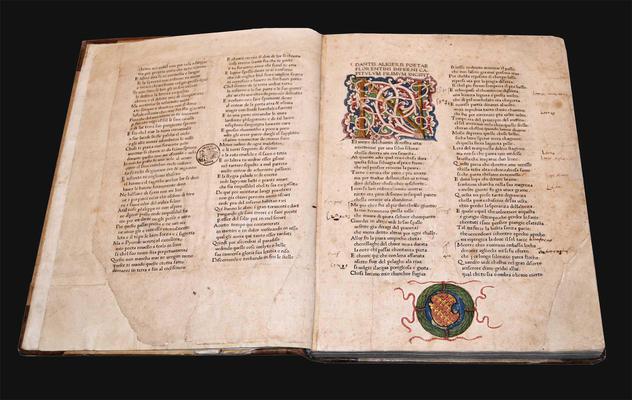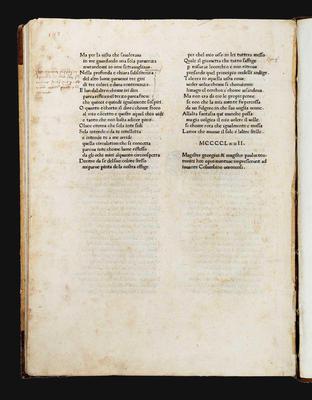Dante Alighieri
Dantis Aligerii poetae florentini inferni capitulum primum incipit.
Mantua, Georgius de Augusta and Paulus de Butzbach, for Columbinus Veronensis, 1472.Folio (320x240 mm). Collation: [a12-1, b-f8, g10, h-k8, l6]. [91] leaves. Complete, including Colombino's Capitulo printed on an extra leaf in the first quire, and often lacking. Text in two columns, 41 lines. Type: 106R. At the beginning of each cantica fourteen-line illuminated initial in gold, with white vinework on red, blue, and green ground (identical in style to those present in the two copies respectively in Cambridge University Library and the Biblioteca Capitolare in Padua, suggesting that they were produced in the same workshop, possibly in Mantua). Initials alternately of red or blue, traces of guide letters. On fol. [a]2r a painted coat of arms, within a laurel wreath. Nineteenth-century half-leather binding. Spine with five raised bands, title in gilt lettering. Corners on rear cover lightly worn. A fine wide-margined copy, old restorations to the lower and outer blank margins of the first two leaves, without any loss. Some leaves browned and spotted; small tears at the lower blank margin of some leaves, a few thin wormholes. Copious Latin interlinear and marginal annotations in Filippo Nuvoloni's own hand. Numerous maniculae in the same hand.
Provenance: Filippo Nuvoloni (1441-1478); the Dante scholar Giovanni Jacopo Dionisi (1724-1808); Sir Thomas David Gibson-Carmichael of Skirling (1859-1926; ex-libris on the front pastedown; Sotheby's, Catalogue of the Valuable Library of Books and Manuscripts of Sir Thomas David Gibson Carmichael, bart. (removed from Castlegraig, Peeblesshire), London 1903, lot 268); purchased for £245 by Bernard Quaritch for Charles Fairfax Murray (1849-1919; A List of Printed Books in the Library of Charles Fairfax Murray, [London] 1907, p. 70, “[Divina Commedia] Mantuae, 1472. Folio. hf. bd. in morocco case”); the Italian politician Sydney Costantino Sonnino (1847-1922); Casa di Dante, Rome (ownership label on the front pastedown and spine; small stamps on some leaves); Livio Ambrogio collection.
The exceedingly rare Commedia printed in Mantua in 1472, competing for priority as the editio princeps of the poem with the Foligno Dante. An extraordinary copy, including the Capitulo by Colombino Veronese, frequently missing in surviving copies, and owned by the dedicatee and possible financial backer of the edition: the Mantuan humanist Filippo Nuvoloni (1441-1478), a friend of Andrea Mantegna.
The text was carefully prepared by the ‘maestro da scola' Colombino (1440 ca. - 1482), who based his edition on the authoritative mid-fourteenth-century manuscript which Boccaccio had sent as a gift to Petrarch between 1351 and 1353 (Biblioteca Vaticana,ms Vat. lat. 3199, or a copy of it),and which would often be used throughout the sixteenth century, above all by Pietro Bembo for the Aldine edition of 1502. Colombino collated this reading with other manuscripts, probably in the Gonzaga library. The text – printed in two columns, without numbering or catchwords – is introduced by the Capitulo di Columbino Veronese, an encomiastic composition in fifty-two tercets printed on a leaf added during the printing, and addressed to Filippo Nuvoloni. The book was printed by Georg de Augusta and Paul Butzbach in 1472: the colophon on the verso of the final leaf mentions only their partnership and the year of printing, and there is as yet no documentary proof of the actual month of its publication. Therefore, the question which town first printed the Commedia – Foligno or Mantua? – remains open.
Georg de Augusta and Paul Butzbach began their activity in Verona in 1471, establishing the first printing-house in the city. They worked in collaboration with the grammaticus Cosma Bogioni and started by producing those texts which were most in demand as schoolbooks. After printing six books (according to ISTC datable to the years 1471-1472), they left Verona and moved – stopping first in Ferrara – to Mantua. A letter written by the Mantuan law student Pietro Adamo de' Micheli on 25 November 1471 to Ludovico Gonzaga allows us to antedate their arrival in the city to this date. He announces to the Marquis that he has founded a partnership with certain printers for introducing printing to Mantua, mainly of law books. However, the first product of the press will not be a voluminous legal treatise, but rather an “operetta de mediocre grandeza, vendibile et grata universalmente”, the Decamerone by Giovanni Boccaccio, a work that was frequently one of the first books printed by a newly established press. The Decamerone was printed – probably at the beginning of 1472 – “in una bellissima littera”, the type R106 newly cut for Georg de Augusta and Paul Butzbach by ‘Niccolò tedesco', a compositore from Lendinara (the equipment, punches and matrices that they had used previously remained in Verona). This font was employed also for printing the Commedia, together with the only other book – according to ISTC – produced by Georg de Augusta and Paul Butzbach before the dissolution of their Mantuan partnership: the Ortographia by Cristoforo Scarpa, also datable to 1472. To these editions we can add the further three assigned by ISTC to de' Micheli in the period 1471-1472: the Aesopus moralisatus, the Tractatus de maleficiis by Angelo Gambiglioni, and the Orologio by de' Micheli himself. These books are printed with the identical type R106 on paper with the same watermark: a stag's head, commonly found in the earliest Mantuan editions. De' Micheli's involvement with printing was over by the end of 1472 because of financial difficulties, Georg moved to Venice, whereas Butzbach continued printing on his own in Mantua until 1481.
In the colophon to the edition of the Decameron the intent to flatter is clear. The formula adopted by de' Micheli – Mantuae impressum Cum ejus florentiss. urbis principatum foeliciss. ageret diuus Lodouicus gonzaga secundus – is part of a strategy to ingratiate himself with the Marquis and gain his patronage. The printing of the Commedia may reflect an identical strategy to win patronage on the part of the newly established press. A book edited by the esteemed grammarian Colombino; a book offering an edition of Dante's famous poem: could a printing house have a more auspicious start? Therefore, the printing might bedatable to earlier in 1472, i.e. when Georg de Augusta and Paul Butzbach began their activity in Mantua: perhaps before 11 April, the date of the Foligno edition. The identity of the first owner of the present copy might confirm this hypothesis, since an examination of sources and related references would suggest that this was none other than the dedicatee himself and possible financial backer of the edition: the Mantuan humanist, poet and diplomat Filippo Nuvoloni.The crucial reference is to be found in the Albo dantesco veronese published in 1865, in which the then librarian of the Biblioteca Capitolare in Verona Giambattista Giuliari records the past presence in the city of three copies of the Mantua Dante, including a remarkable copy once owned by the Nuvoloni family, with three illuminated initials, marginalia in a fifteenth-century hand and a coat of arms painted at the bottom of the first leaf: the identical features found in the present copy. A further significant reference, suggesting strongly that this was the actual copy in the Nuvoloni library, dates from 1776, when the Dante scholar Bartolomeo Pierazzini argued that the marginalia in the volume could be attributed to Nuvoloni himself.
Filippo Nuvoloni was born in 1441 in Mantua, to a distinguished family belonging to the political and literary élite of the city. In 1468 Filippo moved to Ferrara to attend the lessons of Battista Guarini and Lodovico Carbone, and on 8 October he wrote to Lodovico Gonzaga with a request to borrow some Greek books from the Ducal Library, a detail that confirms Colombino's praise of Nuvoloni's mastery of different languages. In March 1471 he was in the entourage which accompanied Borso d'Este on his trip to Rome for his ducal investiture. The unexpected death of the Duke in August interrupted his career in the service of the Estense: Nuvoloni was forced to abandon Ferrara, and in November he moved back to Mantua. His return to his native city coincided therefore with the arrival of the two German printers. The printing of the Commedia, probably financed by Nuvoloni himself and accompanied by Colombino's encomium presenting him as the ‘imitator of Virgil', the Mantuan poet par excellence, may also be read as a courtly homage. Just as such an edition could not have been a more auspicious beginning for the German printers newly arrived in Mantua, could Nuvoloni, with such an undertaking, have had a more triumphal re-entry to the Gonzaga court?
Furthermore, the comparison between the marginalia in this copy and Nuvoloni's letters to Borso d'Este (Modena State Archives) and the autograph manuscript of his work Dyalogo de Amore (Biblioteca Universitaria in Padua,ms243) reveals evident similarities, allowing us to attribute these annotations – one of them, in the margin of fol. [h]5v of the Commedia, is datable to 1473 – to his hand. He annotates words, phrases and passages taken mainly from the definitive redaction of the Comento by Benvenuto da Imola, a late fourteenth-century Latin commentary which had a wide manuscript circulation especiallyin Bologna, Ferrara, and Mantua. Nuvoloni also drew extensively on Dante's poem and Benvenuto's commentary in his Dyalogo de Amore. In the last decades of the eighteenth century the copy of the Commedia was still in the Nuvoloni library in Verona. Probably at the end of the century the volume was bought by the well-known Dante scholar Giovanni Jacopo Dionisi, who in his Aneddoti Danteschi describes the copy now in his possession, mentioning its original provenance and transcribing some marginalia written in the volume. The larger part of Dionisi's collection was bequeathed to the Biblioteca Capitolare in Verona, except for the editions of Foligno and Mantua, which were both in his possession. Both – as Giuliari states in the Albo dantesco veronese – were acquired by a still unindentified ‘straniero Librajo'. This ‘foreign bookseller' may have later offered the Mantua Dante to the collector Thomas David Gibson-Carmichael, a great admirer of the Florentine poet. Carmichael sold his outstanding collection in 1903 by auction at Sotheby's, and the present copy is accurately described in the catalogue: “the editor was Colombino Veronese who dedicates it to Philippo Nuvoloni; the Arms of the latter are painted upon the lower margin of the firstpage of text”.
The Mantua Commedia is extremely rare, even rarer than the Foligno edition. Only 16 copies are listed in ISTC (including this copy), often wanting the first leaf with the Capitulo by Colombino Veronese. The present copy is also the last and only copy to have come onto the market since the early twentieth century.


